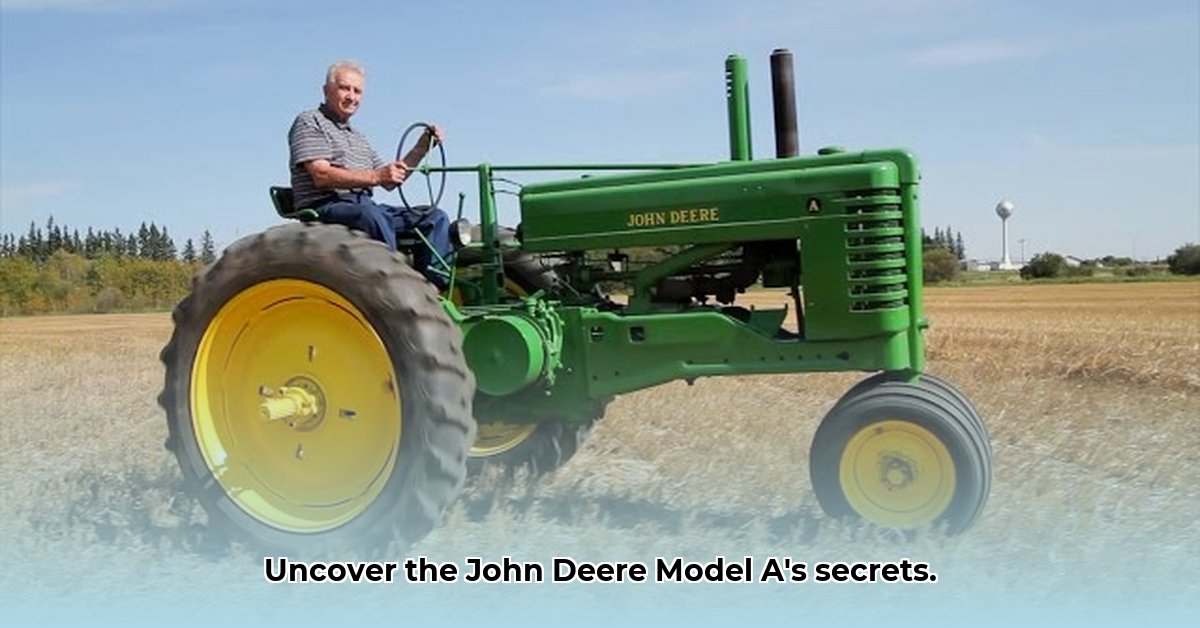
The John Deere Model A tractor: a name synonymous with agricultural history and, increasingly, with passionate collecting. More than just a vintage farm machine, the Model A represents a bygone era of robust engineering and enduring design. This comprehensive guide explores the nuances of this iconic tractor, providing insights into its various models, current market values, and essential advice for prospective buyers and restorers. For more information on serial numbers, check out this helpful resource: Serial Number Lookup.
Decoding the John Deere Model A Family
The John Deere Model A wasn't a single production run; it encompassed a family of tractors, each with its own unique features and specifications. Understanding these variations is crucial for collectors and enthusiasts alike. Key models include the A, AR, AO, AI, AN, AW, ANH, and AWH, each representing incremental improvements and refinements over its production lifespan (roughly 1918-1927). Precise details regarding specific changes between models remain scarce due to incomplete historical records. Think of each variant as a unique sibling within a large family, each with its own individual characteristics.
| Model | Key Differences | Notes |
|---|---|---|
| A | The foundational model; all subsequent models built upon its design. | Established the basic design and features that defined the Model A line. |
| AR | Likely featured enhancements to the rear-end system. | Potential upgrades to strength, functionality or ease of operation. Specifics are unclear. |
| AO | Possibly included operator comfort upgrades. | May have incorporated modifications to improve the operator's experience. Precise changes are unknown. |
| AI, AN, AW, ANH, AWH | Incremental improvements and refinements. | These models reflect gradual technological advancements and evolving user needs. Documentation is limited. |
Diving into the Model A's Technical Specifications
Understanding the Model A's technical specifications is vital, yet inconsistencies exist across various sources. Horsepower figures, for example, often vary widely, likely due to differing testing methodologies of the era. While estimates range from roughly 18 to 36 horsepower, it's critical to consider the source and the specific testing method employed when evaluating such figures. Generally, the Model A featured a two-cylinder engine, a manual steering system (power steering was a luxury then!), and a four-speed, unsynchronized transmission. Its simplicity belied its robust build quality, a testament to the engineering principles of its time.
Navigating the Model A Market: Prices and Influencing Factors
The value of a John Deere Model A can vary significantly, making it a dynamic collector's market. Several factors contribute to these price fluctuations:
Condition: A meticulously restored tractor in pristine condition will command a significantly higher price than one needing major repairs. A perfectly preserved example might fetch upwards of $17,000 at auction, while a project tractor needing considerable work might start around $1200.
Year & Model Variant: Rarity and the specific model significantly impact value. Older, rarer models are naturally more valuable.
Location: Regional collector demand influences prices. Strong collector interest in a particular geographical area can inflate prices above the overall average.
Authenticity & Parts Availability: The authenticity of original parts, as well as the current availability of replacement parts, greatly influences value. A tractor with readily available parts will be more desirable and easier to restore.
Your Model A Buying Guide: A Checklist for Success
Acquiring a John Deere Model A requires careful planning and a methodical approach. The following checklist will help you navigate the buying process:
Thorough Visual Inspection: Examine the tractor comprehensively for rust, dents, or damage. Assess the overall state of preservation.
Engine and Mechanical Inspection: A professional mechanic should assess the engine’s compression, leaks, and overall mechanical soundness. The transmission, hydraulics, and braking systems should also undergo rigorous testing.
Parts Availability Research: Research the availability of original or reproduction parts before purchasing.
Documentation Review: Seek any available documentation, such as service records, owner's manuals, or historical information. This helps establish authenticity and verify the tractor's history.
Test Drive (if possible): Operating the tractor (if the seller allows) is essential for assessing its functionality and mechanical condition.
Professional Appraisal: Consider obtaining a professional appraisal to ensure you're paying a fair market price.
Restoration and Preservation: Keeping History Alive
Restoring a John Deere Model A is a rewarding undertaking but requires significant time and expertise. It’s more than just mechanical restoration; it’s preserving a piece of agricultural history.
Several organizations dedicated to preserving vintage tractors offer invaluable support, resources, and community, connecting you to experts, parts suppliers, and fellow enthusiasts. These organizations are an invaluable resource for advice, parts sourcing, and a sense of community.
Conclusion: A Legacy of Enduring Appeal
The John Deere Model A tractor remains a highly sought-after collectible, representing a fascinating intersection of history, engineering, and passionate collecting. By understanding its various models, market dynamics, and essential buying considerations, prospective owners can navigate the market confidently and preserve these iconic machines for generations to come. The detailed approach outlined above will help ensure that the next chapter in the Model A's story is one of careful preservation and continued appreciation.